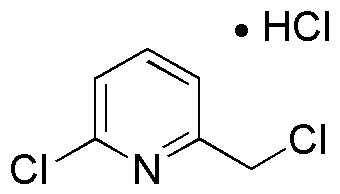2-Methyl-6-chloromethylpyridine hydrochloride is widely utilized in research focused on:
- Synthesis of Pharmaceuticals: This compound serves as a key intermediate in the synthesis of various pharmaceutical agents, particularly those targeting neurological disorders.
- Agricultural Chemicals: It is used in the development of agrochemicals, including herbicides and insecticides, enhancing crop protection and yield.
- Research in Organic Chemistry: As a versatile building block, it aids researchers in creating complex organic molecules, facilitating advancements in chemical synthesis techniques.
- Material Science: The compound contributes to the development of specialized polymers and resins, which are essential in creating durable materials for various applications.
- Analytical Chemistry: It is employed in analytical methods for detecting and quantifying other compounds, improving the accuracy of chemical analysis in laboratories.
General Information
Properties
Safety and Regulations
Applications
2-Methyl-6-chloromethylpyridine hydrochloride is widely utilized in research focused on:
- Synthesis of Pharmaceuticals: This compound serves as a key intermediate in the synthesis of various pharmaceutical agents, particularly those targeting neurological disorders.
- Agricultural Chemicals: It is used in the development of agrochemicals, including herbicides and insecticides, enhancing crop protection and yield.
- Research in Organic Chemistry: As a versatile building block, it aids researchers in creating complex organic molecules, facilitating advancements in chemical synthesis techniques.
- Material Science: The compound contributes to the development of specialized polymers and resins, which are essential in creating durable materials for various applications.
- Analytical Chemistry: It is employed in analytical methods for detecting and quantifying other compounds, improving the accuracy of chemical analysis in laboratories.
Documents
Safety Data Sheets (SDS)
The SDS provides comprehensive safety information on handling, storage, and disposal of the product.
Product Specification (PS)
The PS provides a comprehensive breakdown of the product’s properties, including chemical composition, physical state, purity, and storage requirements. It also details acceptable quality ranges and the product's intended applications.
Certificates of Analysis (COA)
Search for Certificates of Analysis (COA) by entering the products Lot Number. Lot and Batch Numbers can be found on a product’s label following the words ‘Lot’ or ‘Batch’.
Numéro de catalogue
Numéro de lot/série
Certificates Of Origin (COO)
This COO confirms the country where the product was manufactured, and also details the materials and components used in it and whether it is derived from natural, synthetic, or other specific sources. This certificate may be required for customs, trade, and regulatory compliance.
Numéro de catalogue
Numéro de lot/série
Safety Data Sheets (SDS)
The SDS provides comprehensive safety information on handling, storage, and disposal of the product.
DownloadProduct Specification (PS)
The PS provides a comprehensive breakdown of the product’s properties, including chemical composition, physical state, purity, and storage requirements. It also details acceptable quality ranges and the product's intended applications.
DownloadCertificates of Analysis (COA)
Search for Certificates of Analysis (COA) by entering the products Lot Number. Lot and Batch Numbers can be found on a product’s label following the words ‘Lot’ or ‘Batch’.
Numéro de catalogue
Numéro de lot/série
Certificates Of Origin (COO)
This COO confirms the country where the product was manufactured, and also details the materials and components used in it and whether it is derived from natural, synthetic, or other specific sources. This certificate may be required for customs, trade, and regulatory compliance.


